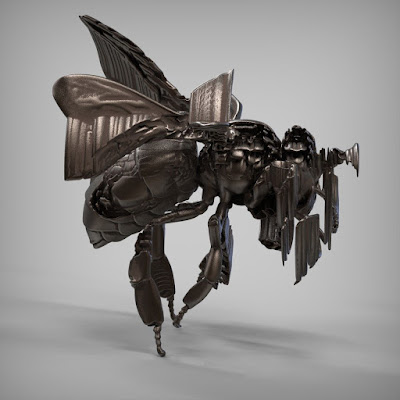Is she threatening to artists, or threatening to women?
 |
| Ai-Da at a tea party photoshoot for the Telegraph, photo by Nicky Johnston. A real woman would have cleaned the silver before entertaining. |
My programmer husband forwarded a story from the Telegraph that was headlined, “Meet Ai-Da: the robot artist giving real painters a run for their money.”
“I don’t think you have anything to worry about just yet,” he told me.
I don’t—but some abstract painters might. “From a basic set of parameters, such as a photograph of some oak trees, or a bee, the robot has rendered abstract ‘shattered light’ paintings warning of the fragility of the environment that would look at home in a top modern gallery,” read Ai-Da’s press release.
 |
| One of Ai-Da’s paintings. I predict she sells out. |
Ai-Da is programmed to sample the colors in the photograph and then reiterate them on a canvas. Such algorithms are basic in computer science. They can sometimes mimic thought, but they lack the intuitive connections that real thinking requires. It’s wonderful that they’ve given Ai-Da a hand to make images the slow, tedious way, but the final results are no more creative or meaningful than a screen-saver.
She is programmed to do a more than this, but she was just delivered from the factory in April, so we must be patient with Baby Girl. She can sketch with a pencil and uses facial recognition technology to draw human faces. Apparently, her coordinate system is programmed in three dimensions, because she can sculpt, after a fashion. Her art videos are included in the show. She can read aloud. Then, too, so can my phone.
 |
| And her sculpted bee, which is substantially less-effectively rendered than a 3D laptop project would be. |
She’s much faster than a human painter. There’s no dithering about light levels, values, composition or meaning, so she can knock off a large canvas in about two hours.
Of course, the real artists are the team that programmed her. That, as you may imagine, is extensive: scientists from Oxford, a robotics firm from Cornwall, and engineers from Leeds.
“Thematically the exhibition questions our relationship with technology and the natural world by presenting how [Artificial Intelligence] and new technologies can be simultaneously a progressive, disruptive and destructive force within our society,” droned the blog Director of Finance. That’s a beautiful parody of the artist’s statement, made funnier because the artist herself has no brain.
 |
| Ai-Da in her studio. Note the artfully-daubed flowing painter’s smock, along with her immobilized feet, photo by Nicky Johnston. |
Ai-Da is having her first solo show at St John’s College, Oxford. If I were in England, I’d probably go, just to see how seamlessly engineers have put the software on my laptop into a large, unwieldy machine.
There’s really no reason for Ai-Da to have a body except to personalize her; she might as well be a hand moving through space, as at the Ford factory. Curator Aidan Meller, who spearheaded the project, conjured up a female minion. Her press photos are set in a studio of campy femininity. But other than her Stepford Wife expression, wig, and long flowing dress, she’s really just a large machine with excessively large hands and feet.
Since the advent of the Industrial Revolution, artists have understood the distinction between machinery and mind. Nobody has yet been able to program an Ai-Da with a Big Idea, the one that gets artists jumping out of bed in the morning and working for a year with no guaranteed return. Nor is there enough money in making paintings to justify building lots of robotic painters. She’s a freak of engineering, and nothing more.
I’m feeling more threatened by the fact that this drone is called a “she”. There’s been a creeping expansion of my personal personal pronoun recently. It’s accompanied by the trappings of what men perceive to be feminine, without any real deep understanding of womanhood. Referring to boats as “she” is as far as I want to see it go in the material world.



